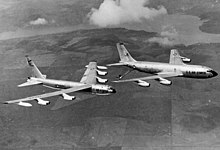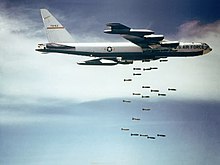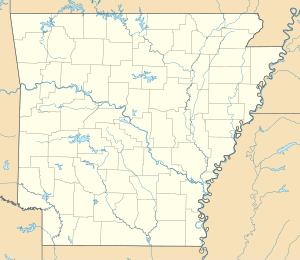Blytheville Air Force Base
| Eaker Air Force Base Blytheville Air Force Base Blytheville Army Airfield | |
|---|---|
| Part of Strategic Air Command/Tactical Air Command | |
| Blytheville, Arkansas | |
| Coordinates | 35°57′52″N 89°56′38″W / 35.96444°N 89.94389°W |
| Type | Air Force Base |
| Site information | |
| Controlled by | 461st Bombardment Wing (1956–1958) 97th Bombardment Wing (1959–1991) |
| Site history | |
| Built | 1942 |
| In use | 1942–1946, 1953–1992 |
Blytheville Air Force Base was a United States Air Force base from 1942, until it closed in 1992. In 1988, the facility was renamed Eaker Air Force Base in honor of World War II General of the Eighth Air Force, Ira C. Eaker.[1] It was located 3 miles (4.8 km) northwest of Blytheville, Arkansas. The facility now operates as the Arkansas Aeroplex and Arkansas International Airport.
History
Constructed on former agricultural land, the site was originally activated as the Blytheville Army Airfield in 1942. During World War II, the site served as a training airfield as part of the 70,000 Pilot Training Program. It was one of many air fields created in the country’s interior during the war for this purpose. Blytheville, Arkansas was selected as a training location due to its proximity to the Mississippi River, where supplies could easily be shipped to and from the site. The airfield was used as the Southeastern Training Command’s flight training school, which closed in October 1945 after the Second World War ended.[1] Then the airfield briefly became a processing center for the rapid demobilization of military personnel being discharged. The War Assets Administration officially closed down the installation in 1946, at which point control and responsibility for the land was transferred to the city of Blytheville.[1]

On 15 July 1955, the facility was reopened as Blytheville Air Force Base (AFB), when the 461st Bombardment Wing was moved from Hill Air Force Base in Utah. Blytheville AFB became fully operational when it was equipped with a wing of three squadrons of B-57 bomber on 19 July 1955.[1] Other aircraft stationed at Blytheville AFB included: KC-97 refueler, B-52G bomber, KC-135A tanker, T-33 jet fighter, and the T-37 trainer—among others.[2] In July 1959, the 97th Bombardment Wing subsequently assumed control of the base and brought with it the long-range B-52G bomber and the KC-135A Stratotanker aerial refueling aircraft to support bomber operations. Blytheville AFB experienced a great deal of activity throughout the Cold War era, when for instance, the 97th Bombardment Wing went on airborne alert in 22 October 1962, during the Cuban Missile Crisis. Two B-52G bombers were readied to strike the Soviet Union with nuclear weapons if necessary—for which the wing received the Air Force Outstanding Unit Award for its performance during the crisis.[1]
During the Vietnam War the 97th Bomber Wing at Blytheville supported strike operations throughout the late 1960s and early 1970s. A bomber crew from Blytheville were among the first shot down during Operation Linebacker II, a December 1972 mission targeting complexes in North Vietnam. Three crewmen died in the crash.[3] Six more men from the 97th were also lost in Vietnam, whose names are recognized on a memorial placard at the former base. In 1972, all of the bombers were temporarily moved to Guam before being returned to Blytheville AFB, at which time the installation resumed normal functions. It launched rescue missions from the base to Grenada in 1983 and in August 1990, the pilots of the 97th Bomber Wing began practicing for missions in the Middle East and eventually supported Operation Desert Storm.[1]

Renamed Eaker AFB and base closure
In 1988, the U.S. Air Force officially renamed Blytheville AFB to Eaker AFB in commemoration of World War II General Ira Eaker, the former commander of the 8th Air Force. Officials had hoped, after hearing rumors of the base's possible closure, that the name would endear the base among military leaders and be enough to incentivize its continued existence.[3] Unfortunately, Eaker Air Force Base topped the Strategic Air Command’s list of base closures in 1991 and with the Cold War coming to an end, the installation was officially chosen; in March 1992, the last aircraft left the base. Extensive efforts to offset the negative economic effects on the community of Blytheville were undertaken by local and federal officials, who cleaned up the site and then distributed the land to various organizations, including the Department of the Interior (DOI), the Fish and Wildlife Service (FWS), and the Department of Veterans Affairs (VA). Some of the land has since been declared a National Historic Landmark.[1]
The base closure cost the community over 700 civilian jobs, but half of these were recovered through the adaptive reuse of the former base, such as United States Post Office's utilization of the base in the late 1990s as an airport hub during the holidays, some of the base housing being converted by Westminster Village of the Mid-South for a retirement community, the construction of a $2.5 million sports complex by the local community, and the private investment of some $3 million for the creation of the Thunder Bayou Golf Course.[1]
Historic district
Blytheville Air Force Base Strategic Air Command (SAC) Alert and Weapons Storage Areas Historic District | |
| Location | 4701 Memorial Drive, Blytheville, Arkansas |
|---|---|
| Coordinates | 35°57′33″N 89°57′47″W / 35.95917°N 89.96306°W |
| Area | 247 acres (100 ha) |
| NRHP reference No. | 100001999[4] |
| Added to NRHP | 26 January 2018 |
The Blytheville Air Force Base Strategic Air Command (SAC) Alert and Weapons Storage Areas Historic District was listed on the National Register of Historic Places in 2018.[4]
It is a 247 acres (100 ha) historic district which included 23 contributing buildings, 33 contributing structures, two contributing sites, a contributing object, as well as two non-contributing buildings.[5]
Major commands to which assigned


- Army Air Force Flying Training Command, 10 June 1942 – 16 June 1945
- Continental Air Forces, 16 June 1945 – 21 March 1946
- Redesignated Strategic Air Command, 21 March 1946 – 1 April 1946
- Tactical Air Command, 1 April 1946 – 15 August 1946, 10 June 1953 – 1 October 1953
- Air Materiel Command, 1 October 1953 – 1 July 1954
- Tactical Air Command, 1 July 1954 – 1 April 1958
- Strategic Air Command, 1 April 1958 – 1 June 1992
- Air Combat Command, 1 June 1992 – 15 December 1992 (not operational)
Major units assigned
- 25th Twin Engine Flying Training Group, 25 July 1942 – 29 February 1944
- Army Air Force Pilot School, 3 May 1942 – 31 May 1945
- 211th Army Air Force Base Unit, 1 May 1944 – 15 June 1945
- 809th Army Air Force Base Unit, 16 June 1945 – 31 March 1946
- 334th Army Air Force Base Unit, 1 April 1946 – 25 November 1946
- 461st Bombardment Wing, 8 April 1956 – 1 April 1958
- 4329th Air Base Squadron, 1 April 1958 – 1 July 1959
- 97th Bombardment Wing, 1 July 1959 – 1 September 1991
- Redesignated: 97th Wing, 1 September 1991 – 1 April 1992
Major aircraft assigned
- North American AT-6, 1942–1944
- Curtiss AT-9, 1942–1944
- Beech AT-10, 1942–1944
- Republic AT-12, 1942–1944
- North American TB-25, 1944
- Curtiss C-46, 1945
- Douglas C-47, 1945
- Martin B-57 Canberra, 1956–1958
- Boeing B-52G Stratofortress, 1960–1992
- Boeing KC-135A Stratotanker, 1961–1992
See also
- Arkansas World War II Army Airfields
- 30th Flying Training Wing (World War II)
- Eaker Site, a major archaeological site within the base's grounds
References
- ^ a b c d e f g h Hartley 2018.
- ^ AFCEC, "Eaker Air Force Base Community Relations Plan".
- ^ a b Heard 2018.
- ^ a b "National Register of Historic Places: Weekly list". National Park Service. 26 January 2018.
- ^ Edward Salo; Edward Harthorn; Zach Mitchell; Frank Walker; Travis Raterman (11 September 2017). "National Register of Historic Places Registration: Blytheville Air Force Base Strategic Air Command (SAC) Alert and Weapons Storage Areas Historic District" (PDF). National Park Service. Retrieved 19 February 2018. With maps and 23 photos.
Bibliography
- Hartley, Jillian (2018). "Eaker Air Force Base". Encyclopedia of Arkansas.
- Heard, Keneth (2018). "Arkansas Officials Seek Cold War Museum for Former Air Base". US News.
- U.S. Air Force Civil Engineer Center. "Community Relations Plan for the Former Eaker Air Force Base Blytheville, Arkansas (July 2007}" (PDF). AFCEC.mil. Retrieved 26 May 2019.
External links
- Installations of the United States Air Force in Arkansas
- Airports in Arkansas
- Strategic Air Command military installations
- Military installations closed in 1988
- Transportation in Mississippi County, Arkansas
- Buildings and structures in Mississippi County, Arkansas
- 1988 disestablishments in Arkansas
- Blytheville, Arkansas
- National Register of Historic Places in Arkansas






